UPDATED BELOW 18-6-2025
I have now reported that the closed Black Potts footbridge on RBWM Datchet Footpath 4 has no advance warning or diversionary signage. RBWM is awaiting an engineer’s inspection report. I have also submitted a Member Question for the next Council Meeting as follows:
UPDATED BELOW 17-6-2025
Black Potts footbridge on RBWM Datchet Footpath 4 is now CLOSED until further notice due to safety concerns. Unfortunately there are still no advance warning or diversion notices in place.
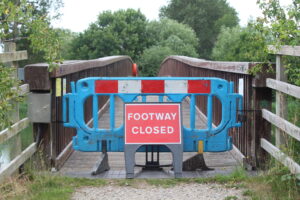
Here is a short YouTube video
(This is Datchet footpath 4 from: SE end of FP 38 Eton at Black Potts Footbridge, crossing the footbridge to FP 3 Datchet north of Black Potts Viaduct.)
It looks like Black Potts footbridge is now deemed unsafe and closed until further notice. This is only 18 months after a structural inspection report claimed it was ‘basically sound’. So what about the future? Repair – I think not! As for replacement – this involves footbridge closure and a footpath diversion for years, accompanied by enormous cost and disruption. Another question – what about the other wooden footbridges over the Jubilee River?
UPDATED BELOW 11-6-2025
I raised the Black Potts footbridge issue as a Member Question at the RBWM Council Meeting on 21-11-2023. You can find the RBWM Council Meeting Minutes here
Below is a transcript from the 21-11-2023 Minutes:
Councillors’ Questions
a) Councillor Larcombe asked the following question of Councillor Coe, Cabinet Member for Environmental Services
The construction of the Jubilee River by the Environment Agency over two decades ago resulted in more than twenty new or modified bridges. Can you tell me please – how many of these bridges are now partially or wholly the responsibility of RBWM?
Written response: Only a small section of the Jubilee River passes through the borough and according to our records, the structures for which RBWM are wholly responsible for are:
2610 BLACK POTTS FOOTBRIDGE
2453 POCOCKS LANE
2756 THE MYRKE FOOTBRIDGE (aka MICHAELS BRIDGE)
Councillor Larcombe thanked Councillor Coe for his answer. He stated that the Jubilee River was now called the Jubilee Flood Relief Channel. The Berry Hill Footbridge, which is not in the borough, was removed as it failed and was removed about two years ago. It is due to be replaced by Bucks County Council at a total cost of about £500,000. He stated that it had cost £100,000 to remove the 35m long footbridge. Dorney Wetlands footbridge, also not located in the borough, decking had already failed. Slough Borough Council were responsible for that bridge. He believed that the Council’s two timber bridges located at Black Potts and The Myrke were at the end of their lives. He estimated that the removal and replacement costs would exceed £2m. He stated that the Environment Agency who had designed and installed
these bridges had cut the costs at every opportunity. He asked that, given the Environment Agency designed and installed these bridges, was it fair and reasonable that the RBWM
budget should have to bear these costs? He queried how the Council had taken on the responsibility for these things.
Councillor Coe replied that he had been supplied with the condition reports and the opinion of the chartered engineer at Project Centre was that all three bridges were basically sound.
There may need to be some work in replacing the decks on the wooden bridges but the structural elements were in good order. He did not think the council would be worrying about a £2m cost in the very near future. In relation to the adoption of the bridges, he confirmed that they had been adopted, they were the council’s responsibility including the third bridge across Pococks Lane which carries the road from Eaton to Datchet near to Thames Valley Athletic Centre to be maintained. He advised that he was still waiting for detailed advice to confirm whether the council had to adopt them or was a choice. He noted the adoptions of the structures occurred about the same time as local government reorganisation in Berkshire which complicated the tracking of this issue for officers.
UPDATED BELOW 4-6-2025
Deja vu? I remember that in early 1988 I tried (and failed) to bring gravel working and railway proximity issues to the attention of Wraysbury Parish Council. In May 1988 – the railway bridge at Wraysbury Station collapsed due to water erosion – leaving rails and sleepers hanging in space. The entire sorry tale (including images) can still be seen and read on my other web site here.
UPDATED BELOW 2-6-2025
Black Potts footbridge – a wooden structure over the Jubilee River between Datchet and Eton – is now about 25 years old and showing signs of its age. I have no doubt that this structure fits neatly into the OOSOOM category (i.e. Out Of Sight – Out Of Mind) where it is fair to say that nothing happens until it is probably too late.
This bridge was originally part of the Maidenhead, Windsor and Eton Flood Alleviation Scheme. The Environment Agency was in charge of the construction phase of the MWEFAS project from about 1995 to 2002. Responsibility for the footbridge was then transferred from the Environment Agency to the local authority (in this case RBWM) sometime after the project was completed. Below is an recent image of the footbridge looking upstream from Black Potts railway bridge.
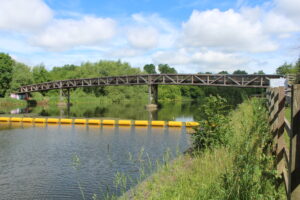
The timber structure is approaching the end of its design life and exhibiting significant signs of stress as can be seen in my images below – all dated May 2025.
Note the sagging of the timber structure and also the cracking at the nodal points – extending to the right towards and into the bolted connector plate. This is not a good sign.
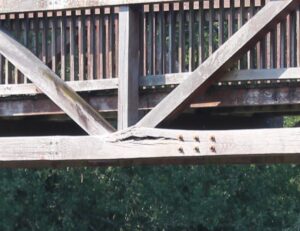
Below (in a series of four images from left to right) is a closer view of this major structural defect.
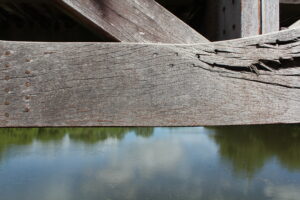
Note the light penetrating through from behind the beam. It is apparent that tension in the right-hand diagonal has caused the beam to split. The fasteners between the beam and the post are no longer functional.
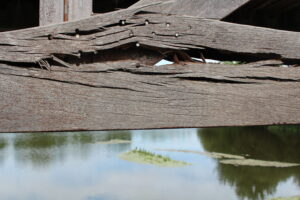
The beam splitting extends into the bolted area to the right.
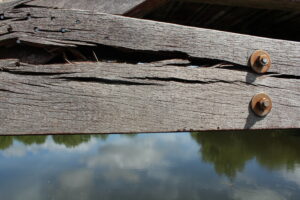
Still further to the right you can see daylight through the beam just to the left of the upper left fastener
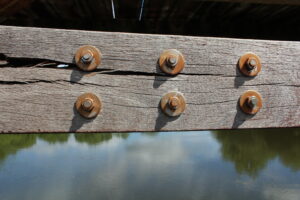
Here the vertical post has pulled out of horizontal beam and the fasteners are no longer functional.
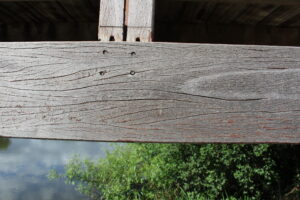
A slightly different view of the same problem.
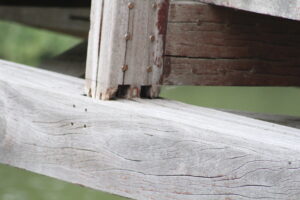
Significant issues at the East end load bearing node.
This image is really interesting when compared to the identical mortice and tenon arrangement on the collapsed Ashford Lane footbridge at Dorney. Although the arrangement appears to retain some strength – in fact the similar feature on the Ashford Lane footbridge was totally rotted internally. (Note inserted 3-7-2025)
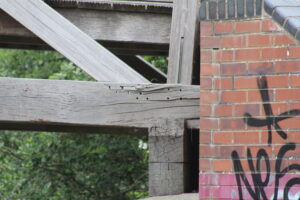
This is a close-up view of the East end.
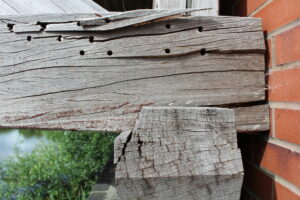
Below is the similar feature on the Ashford Lane footbridge. The timber beams and associated connecting joints were so rotten that when the collapse occurred, the beams were not only disconnected from the remaining structure but were also laterally and longitudinally displaced. (Note inserted 3-7-2025)
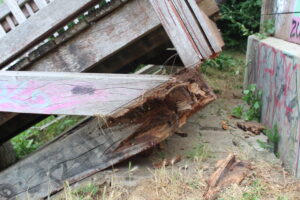
Here the right hand diagonal load bearing member is pulling out of the fissured horizontal beam. The fastenings are completely disengaged and non-functional.

This is the close-up view showing tension between the horizontal beam and the post.
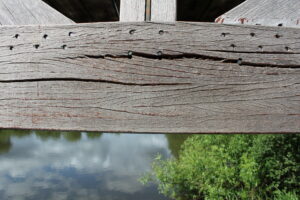
Here the left hand diagonal joint is rotted. The vertical post is pulling out of the horizontal beam.
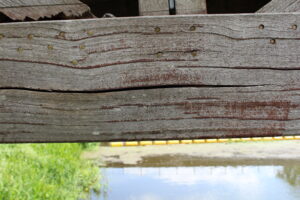
Here the timber is splitting along the grain which lays at an angle to the timber face instead of parallel.
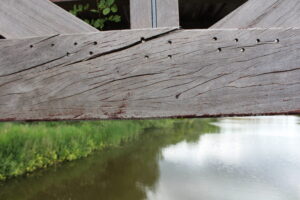
The structure is now clearly sagging on right hand side adjacent to the life-belt.
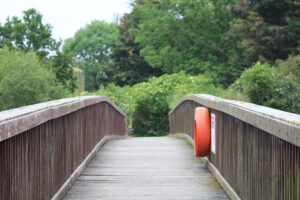
Black Potts Footbridge – Datchet – Condition Report – May 2025.
I have raised this issue before due to similarities with the Berry Hill Footbridge at Taplow – i.e. sub-standard design and/or construction, structural failure, path closed and unusable for years, expensive removal, expensive and partial metal replacement solution (total about £450k – but that’s OK because Buckinghamshire paid).
Black Potts Footbridge over the Jubilee River is made primarily of wood and was constructed by the Environment Agency about 25 years ago.
I am raising this matter again. This structure is now showing significant signs of ageing and wear including consequential sagging due to related stress – please see images. The decking is also degrading. We do not need a replay of the Berry Hill Footbridge saga. Somebody has to take some action!
Thus the issues are as follows:
- Recognition that Black Potts Footbridge is a problem – maybe even dangerous.
- Who is accountable for a 25 year capital asset structural life on a 50 year project?
- Confirmation of who is now responsible for fixing this problem?
- Who is going to pay? (My estimate – this could easily be over £1m).
- How long will the job take?
- When will the job be complete?
- And what about the other wooden footbridges over the Jubilee River?
Here is the short YouTube video
Thank you to Carl Douglas of Chertsey who submitted the following response on 2nd June 2025:
Is this bridge still in use? If so, that should cease immediately.
This bridge comprises 3 sections of paired lattice trusses supporting the 2 sides of the the bridge deck.
It is seriously failing due poorly selected timber, poor design,
weathering and potentially catastrophic lack of competent maintenance.
Under service loads, the diagonal and vertical elements of the lattice are under tension as they carry both the bridge deck loads and the inherent shear loads of the truss. These members are tenoned into the lower longitudinal beam, and the sockets for the tenons have seriously reduced the cross-section of the beam at this point of maximum loading.
At such locations it is normal practice to have additional material, as plates, applied to the vertical faces of the timbers in order to spread and absorb their locally high cross-grain loading of the longitudinal beam. I should note that, in steel lattice girder bridges, it is normal to weld on plates that reinforce the regions where the diagonal and vertical members join the lower horizontal beam.
Timber, loaded across the grain, typically has <20% the tensile strength that it has along the grain. So the combination of reduced cross-section (due to the sockets for the tenons), weathering (with water and ice invading those sockets), cyclic loadings as people walk across, etc., have evidently exceeded the cross-grain load capacity of the timber.
It is also clear that the service loads have been pulling the tenons from their sockets and splitting apart the lower beam. Further, it is clear that the timber of the lower beam is anything but straight-grained, further reducing its fitness for purpose and facilitating splitting.
Particularly concerning, from the H&S point of view, is that those responsible for maintaining this bridge have resorted to multiple attempts to nail together these failing joints! The truss is clearly unsafe and under no circumstances should it be used until properly rebuilt/replaced.
I am shocked that the Environment Agency has allowed this bridge to deteriorate so far, and has resorted to the crudest and most pathetic of attempts to bodge the failed joints.
I am ready to elaborate, on request. Please note that I have extensive and ongoing professional experience of engineered wood structures.
Regards – Carl Douglas MSc
I have added a contact form below:
Ewan Larcombe 31 May 2025
Your message has been sent
END


It is interesting to note that generally the main stress to the structure appears to be emanating from the upstream side of the bridge. this is where the initial flood impact starts.
Therefore I ask if the the bridge supporting footings have been surveyed for alignment in x-x and y-y directions plus settlement.
Bearing in mind during flooding that occurred in 2014 attained a height and flow that was on the design limit of the whole of the JR where many structures failed as a consequence of poor design and cost cutting resulting in millions of pounds of rectification costs to the public purse.
Are the stresses shown the results of latent design defects now becoming apparent.
W S Atkins provided a detailed and substantive report on the EA failures , what is the name of the company that recently surveyed this bridge, were they aware of the Atkins report. Also why would RBWM take responsibility of a wooden bridge 25 years old when it knew that all the JR structures were a risk failure from 2003. Questions should be asked if the approving Cllrs were qualified to make that decision on behalf of the public with independent evidence of risk available.